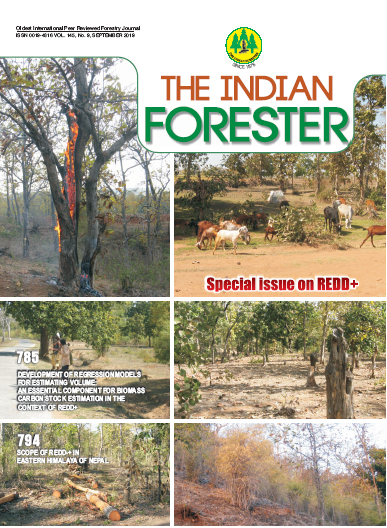Development of Regression Models for Estimating Volume: An Essential Component for Biomass Carbon Stock Estimation in the Context of REDD+
DOI:
https://doi.org/10.36808/if/2019/v145i9/148676Keywords:
Biomass, Carbon, Regression Model, REDD .Abstract
Volume of a tree needs to be estimated most accurately because volume forms the basic and critical block for sustainable forest management. The volume is also essential to obtain biomass and carbon stock using biomass conversion and expansion factors. A total of 10 candidate regression models were fitted, hence 16 models each for 10 species (Alnus nepalensis, Betula utilis, Castanopsis tribuloides, Juniperus recurva, Larix griffithii, Pinus roxburghii, Pinus wallichiana, Quercus griffithii, Quercus lanata and Schima wallichii). The models were assessed and selected based on the Akaike Information Criterion (AIC) and Bayesian Information Criterion (BIC) values. Lower the values of AIC and BIC, better the fit of the models. The models fitted with basal area x height with restricted natural cubic spline functions were observed to be the best fit models for all 8 species, whereas for two species (Quercus griffithii and Schima wallichii) the model fitted with basal area as predictor was observed to be the best. While for 8 species (Alnus nepalensis, Betula utilis, Castanopsis tribuloides, Juniperus recurva, Pinus roxburghii, Quercus griffithii, Quercus lanata and Schima wallichii), the models with heteroscedasticity being modelled using var. Power function were observed to be the best fit, the model with heteroscedasticity being modelled using var. ConstPower function was observed to be the best fit for Pinus wallichiana and Larix griffithii.References
Avery T.E., and Burkhart H.E. (1983). Forest Measurements, Third Edition. McGraw-Hill, New York, 331 pp.
Goulding C. (1979). Cubic spline curves and calculation of volume of sectionally measured trees. NZJ Forest Science, 9(1): 89-99.
Hummel S., Hudak A.T., Uebler E.H., Falkowski M.J., and Megown K.A. (2011). A Comparison of Accuracy and Cost of LiDAR versus Stand Exam Data for Landscape Management on the Malheur National Forest. J. Forestry, 267-273.
Laumans P. (1994). Height-diameter functions from PIS for country-level site classification and local volume table selection. Thimphu.
Sadiq R.A. (2006). A new approach to log volume estimation. Southern J. Applied Forestry, 30(1): 30-39.
Downloads
Downloads
Published
How to Cite
Issue
Section
License
Unless otherwise stated, copyright or similar rights in all materials presented on the site, including graphical images, are owned by Indian Forester.





